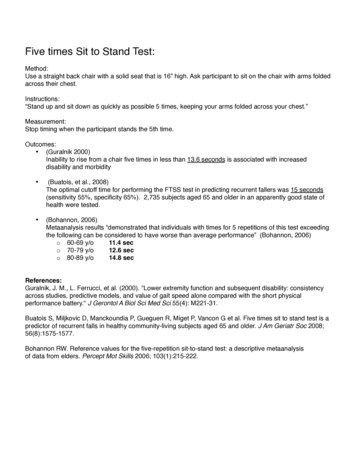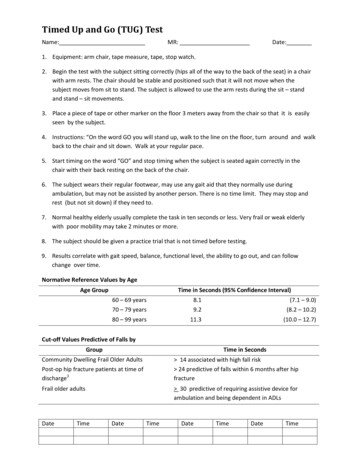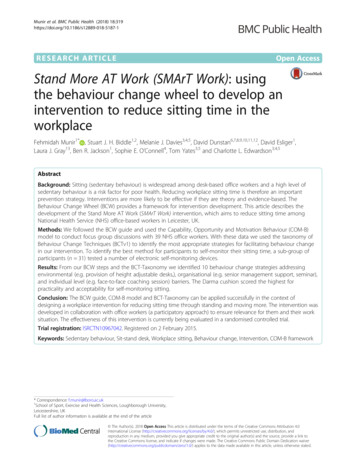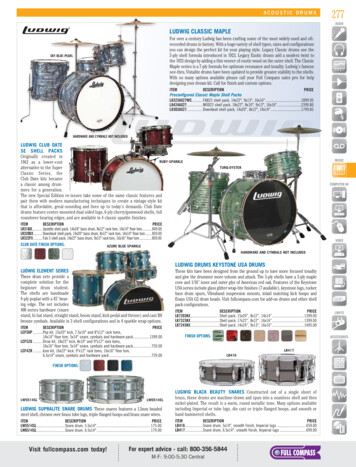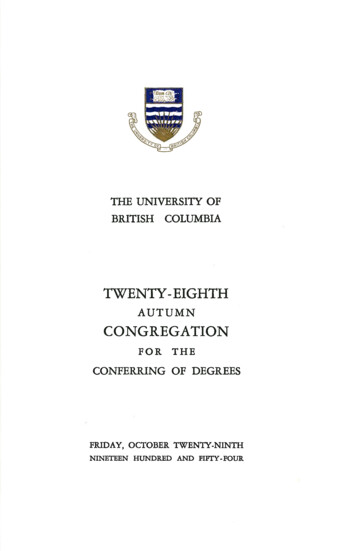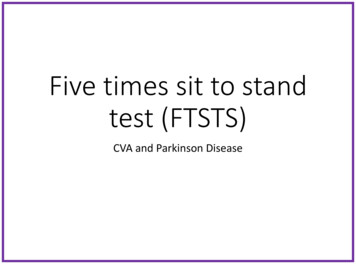
Transcription
Five times sit to standtest (FTSTS)CVA and Parkinson Disease
Five times sit to stand test (FTSTS) Stroke Recommended for inpatient and outpatient rehab aswell as acute care Parkinson’s Disease Highly recommended for in H and Y stages 1-4 G code Changing and maintaining body position
FTSTS Purpose of test Originally developed to assess LE strength now also usedto assess functionWhitney, S. L., Wrisley, D. M., Marchetti, G. F., Gee, M. A., Redfern, M. S., &Furman, J. M. (2005). Clinical Measurement of Sit-to-Stand Performance in PeopleWith Balance Disorders: Validity of Data for the Five-Times-Sit-to-Stand Test.Physical Therapy, 85(10), 1034-1045.
FTSTS Equipment needed 43 cm height chair (17 inch chair) Stop watch
FTSTS How to administer All subjects begin by crossing their arms on their chestand sitting with their back against the chair Provide the following instructions: “I want you to standup and sit down 5 times as quickly as you can when Isay 'Go'.” Start timing when signaled “Go” and stop when thesubject’s buttocks touched the chair on the fifthrepetition. Instruct to stand up fully between repetitions of thetest and not to touch the back of the chair during eachrepetition.
ResearchCVA
Reliability/Cut off scores 12 subjects one year post stroke, 12 healthysubjects over 50, 12 subjects between the age of21-35 Excellent interrater, intrarater and test-retestreliability Cut off scores of 12 seconds to determine healthyfrom subjects with stroke Mong, Y., Teo, T. W., & Ng, S. S. (2010). 5-repetition sit-to-stand test in subjects withchronic stroke: reliability and validity. Arch Phys Med Rehabil, 91(3), 407-413.
Foot and ArmPlacementHands on thighlonger times thanaugmented arm45 community dwelling subjects at least oneyear post stroke Seat height adjusted to leg length Normal-Hips 90, ankle neutral Posterior-feet 10cm back from normal Each subject performed each condition(order determined by random draw) This study did not determine the bestposition to perform the test but raisedthe question that standardizations ofarm and leg positions should beestablished Kwong, P. W., Ng, S. S., Chung, R. C., &Ng, G. Y. (2014). Foot placement andarm position affect the five times sit-tostand test time of individuals withchronic stroke.All posterior foot placements had shorter times
Seat height andarm position43 community dwelling subjects with history of at least one year post stroke.Each subject performed each condition with order randomly selected Subject sat with knee is 90 degrees. Knee height was measured Chair was adjustable but without armsSlowertimes Ng, S. S., Cheung, S. Y., Lai, L. S., Liu, A. S., Ieong, S. H., & Fong, S. S. (2013). Association ofseat height and arm position on the five times sit-to-stand test times of stroke survivors.Slower times85% knee height 100%Arms acrossArms acrosschestchest110%Arms acrosschest85%Hands on thighs110%Hands on thighs100%Hands on thighs
Validity Has not been found to be valid measure offunctional mobility and dynamic balance withstroke patients But has with elderly women (correlates with TUG);vestibular disorders (TUG and ABC) Whitney, S. L., Wrisley, D. M., et al. (2005). "Clinical measurement of sit-to-stand performance inpeople with balance disorders: validity of data for the Five-Times-Sit-to-Stand Test." Phys Ther85(10): 1034-1045. Meretta, B. M., Whitney, S. L., et al. (2006). "The five times sit to stand test: responsiveness tochange and concurrent validity in adults undergoing vestibular rehabilitation." J Vestib Res 16(45): 233-243. Goldberg, A., Chavis, M., Watkins, J., & Wilson, T. (2012). The five-times-sit-to-stand test: validity,reliability and detectable change in older females. Aging Clin Exp Res, 24(4), 339-344.
ResearchParkinson Disease
Reliability 80 subjects, H&Y 1-4, tested during “on” phase Interrater Reliability .99 2 raters simultaneously timed the subject Test-retest reliability .76 7 days between testingDuncan, R. P., Leddy, A. L., & Earhart, G. M. (2011). Five Times Sit-to-Stand TestPerformance in Parkinson's Disease. Archives of Physical Medicine andRehabilitation, 92(9), 1431-1436.
Cut off scores/Correlations 16 seconds discriminated between fallers and nonfallers Significantly correlated to 6MW, Freezing of Gait,balance confidence, Mini-Best, and 9 hole peg testDuncan, R. P., Leddy, A. L., & Earhart, G. M. (2011). Five Times Sit-to-Stand TestPerformance in Parkinson's Disease. Archives of Physical Medicine and Rehabilitation,92(9), 1431-1436.
Bruininks-Oseretesky Test ofndMotor Proficiency-2 Ed. (BOT-II)14
Bruininks-Oseretesky Test ofMotor Proficiency-2nd Ed.(BOT-II) Test of motor proficiency RH Bruininks & BD Bruininks (1978), 2nd ed 2005 Developed by father/son team; Father is apsychologist; son is exercise science doctoralstudent 2nd ed. standardized on 1,520 children over 1 year fromNov. 2004-May 2005 Norms extended through 21 yrs 11 mths which coversthe entire school-age range served under IDEA (IDEA2004) ICF: body structure and activity15
BOT-IINorming based on 2001 census 12 age groups Equal number males and females Socioeconomic status ( used mother’s educationalattainments); closely matched US population Race/ethnicity stratified according to national census( African American, Hispanic, White and other) 4 regions of country ( Northeast, North Central, Southand West) Educational Placement: Used children with ADHD,Emotional/behavioral disturbance, Specific LearningDisability, Mental Retardation, Developmental delay;Speech/language impairment, other impairment16
Reliability Internal Consistency reliability: 0.7-0.8 Test-retest reliability of subtest: Age 4-12 0.70 Age 13-21 0.69 Test Retest reliability of composite score: Age 4-12 0.80 Age 13-21 0.7717
Validity Interrater reliability0.98-0.99 for manual coordination, bodycoordination and strength & agility0.92 for fine manual control Strong content validity, internal structure, andconstruct validity18
Administration and ScoringBOT-II Purpose: Assessgross and finemotor control skillin children 4 yrs to 21 years ofage. Format: DirectAssessment andobservation ofchild in structuredenvironment. Scoring: Rawscores; standardscores, and ageequivalents foreach area. OverallGM and FM agesand scores. Time: 45 - 60minutes for entiretesting battery. 15 - 20 minutes forshort form.19
Construct and StructureBOT-II Assesses proficiency in 4 motor-areacomposites Fine Manual Control Assesses motor skills involved inwriting and drawing Manual Coordination Assesses reaching, grasping,manipulating objects with anemphasis on speed, dexterity andcoordination of arms and hands Body Coordination Assesses balance and coordinationof U/LEs Strength & Agility Assesses large Ms strength, motorspeed and motor skills involved inmaintaining good body positionwhile walking and running20
8 SubtestsBOT II Fine motor precision Fine motor integration Manual dexterity Bilateral coordination Balance Running speed and agility Upper limb coordination strength21
BOT-II For each subtest Point Score Standard Score Percentile Rank Stanine Age Equivalent Lowestpossible 4 yrs Highestpossible19 yearsand above Gross MotorComposite Fine MotorComposite Battery Composite22
Descriptive Categories Corresponding to Scale Score, StandardScores, Percentile Ranks, and Standard Deviations from theMeanDescriptiveCategoryScale Deviationfrom theMeanWellAboveAverage23 orgreater70 orgreater98 orgreater2.0 orgreaterAbove 1.0-(1.0)Below Avg6-1031-403-17-2.0- (1.0)Well-BelowAvg5 or less30 or less2 or less-2.0 orless23
Sensory Observations onBOT - 2 Tactile- Not readily observable Proprioceptive––––––Running Speed and AgilityThumb to Fingertip ( eyes closed)Touching Nose ( eyes closed)Stepping over stickPressure on pencilDuring bilateral items, needing to havevisual regard24
Sensory Observations onBOT- 2 Proprioceptive (cont.)– Posture and tone Vestibular– Balance subtests– Jumping items; difficulty with feetoff ground– Freedom of movement25
Sensory Observations onBOT-2 Motor Planning– Bilateral items may indicate motorplanning– Watching hand position andmovement on ball items Other– Speed processing– Rhythmicity of movement26
Six Minute Walk (6MW)
6 min walk CVA Highly recommended for inpt and outpatient rehab,acute care Parkinson Disease Highly recommended for stage 1-4 G Code Mobility: Walking and moving around Pediatrics
6MW Brief Description How to administer
ResearchCVA
Reliability/MDC High test-retest reliability MDC-52 meters (171 feet) Correlated with gait speed Fulk, G. D., Echternach, J. L., Nof, L., & O'Sullivan, S. (2008). Clinometric properties of thesix-minute walk test in individuals undergoing rehabilitation poststroke. Physiother TheoryPract, 24(3), 195-204.
ResearchParkinson Disease
MDC/Reliability 37 subjects with PD, H&Y 1-4, on medication MDC-82 meters (269 feet) Test-retest reliability- .96 Steffen, T., & Seney, M. (2008). Test-Retest Reliability and MinimalDetectable Change on Balance and Ambulation Tests, the 36-ItemShort-Form Health Survey, and the Unified Parkinson Disease RatingScale in People With Parkinsonism. Physical Therapy, 88(6), 733-746.
Provide the following instructions: “I want you to stand up and sit down 5 times as quickly as you can when I say 'Go'.” Start timing when signaled “Go” and stop when the subject’s buttocks touched the chair on the fifth repetition. Instruct to

